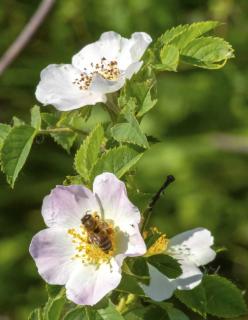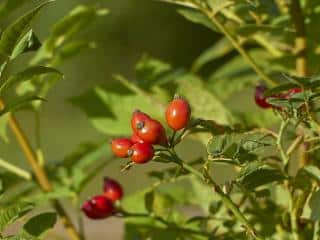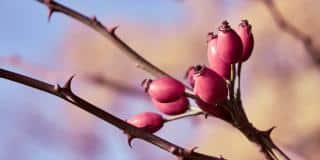

Plant a dog rose bush in a corner of your garden.
Simple Dog rose facts
Name – Rosa canina
Family – Wild rose tree
Type – rose tree
Height – 3 to 10 feet (1 to 3 m)
Breadth – 3 to 10 feet (1 to 3 m)
Exposure – full sun, part sun
Soil: rich – Foliage: semi-evergreen, deciduous – Flowering: spring, summer
Dog rose in the wild grows in forest clearings and along swaths of open terrain: this is why sun and part shade are its favorite exposure.
Dog rose is an easy, hardy shrub, that most often is quite happy in all types of soil.
 The best season to plant dog rose is fall, and second to that, spring.
The best season to plant dog rose is fall, and second to that, spring.
Its small size makes it the ideal shrub for shrub beds, standalones or for wild hedges, on the condition that no pathways go through or near it because of thorns.
To propagate a dog rose, collect cuttings 8 inches (20 cm) long from the tips of the sprigs that have grown during the year. Bury the lower part in a blend of ⅔ light garden soil and ⅓ sand, and set it on the side of the house facing away from the equator. Maintain moisture in the soil during the entire winter.
In spring, transplant your rooted cuttings in healthy, well-drained soil that is well exposed to the sun. Mulch to ease regrowth.
As mentioned earlier, dog rose is a very easy shrub.
If you prune your dog rose on a regular basis (once a year), you’ll be giving it what it needs to have a better growth, a nice stature and better blooming from spring to fall.
Plant a dog rose bush in a corner of your garden: it will charm you with its beautiful flowers in spring and you’ll eat its fruits all winter long as true delicacies!
 Very ornamental during the blooming with its delicate elegant flowers with white or pink petals, the dog rose is covered in little red fruits in fall. These fruits, called rose hips, have incredibly high levels of vitamin C: you would need 35 oz (1 kg) of lemons to produce the same amount of vitamin C contained in 3.5 oz (100 g) of rose hips!
Very ornamental during the blooming with its delicate elegant flowers with white or pink petals, the dog rose is covered in little red fruits in fall. These fruits, called rose hips, have incredibly high levels of vitamin C: you would need 35 oz (1 kg) of lemons to produce the same amount of vitamin C contained in 3.5 oz (100 g) of rose hips!
To savor them all winter long, collect them after the first frost – this will soften the fruits – and dry them without delay by placing them near a heat source. Add them to your tea in the morning, you’ll be energized for the whole day!
Planting a dog rose is within reach of every gardener. For the best type of rose hips, select the “Rosa villosa“ variety, also called hairy dog rose: its fruits contain the highest amounts of vitamin C. The hairy aspect of it is a distinctive identification marker.
Dog rose is a gold mine for pharmacopeia: the buds stimulate the body’s immune system, and pincushion gall that occasionally grows on the plant can be used in a similar manner as the dog rose hips themselves, for herbal tea or invigorating decoctions.
 Culinary wonders, rose hips are part of many recipes: jellies, jams and even “ketchup”. Indeed, rose hip, when cooked, releases a thickening agent that gives even a simple mug of boiled water a thick, creamy sensation when drinking.
Culinary wonders, rose hips are part of many recipes: jellies, jams and even “ketchup”. Indeed, rose hip, when cooked, releases a thickening agent that gives even a simple mug of boiled water a thick, creamy sensation when drinking.
Before using them in a culinary preparation, run the fruits through a sieve to remove seeds and whiskers (these are prized “itching powder” for childhood pranks): they’re both diuretic and irritating.
M.-C. H.
If you have trouble growing roses because of the soil in your garden, use dog rose as a grafting root stock. It can grow almost anywhere and is fully compatible with all types of roses!